|
 |
|
Published
by : PROFESSIONAL MEDICAL PUBLICATIONS |
|
ISSN 1681-715X |
|
|
|
|
|
- |
|
ORIGINAL
ARTICLE |
|
- |
|
Volume 24 |
April - June 2008 (Part-II) |
Number 3 |
|
|
|
Predictors of side branch occlusion and its
early complications after angioplasty
in bifurcation lesions
Ali Ghayemian1, Y. Nozari2,
M. Safir3, Reza A. Mohammadpour4
ABSTRACT
Objective: Coronary angioplasty in
bifurcation lesions has lower success rate and more complications than other
lesions. We performed this study to define early complications of angioplasty
in these lesions and to find the predictive factors of major side branch (more
than 1mm) occlusion.
Methodology: In this study, 104
consecutive patients with bifurcation lesion in a single center were
evaluated. The side branches were classified based on diameter and morphology
of the lesions.
Results: In 41 (39.4%) patients side
branch compromise (SBC) occurred. In patients with SBC 34.1% had chest pain
and in 3 (2.9%) patients non–Q wave myocardial infarction (MI) occurred, all
after SBC. The incidence of non-Q wave MI after SBC was 7.3%. The probability
of SBC in patients with ostial lesion of more than 50% was significantly
higher (p=0.021) than patients without such a lesion. Also, if the main branch
lesion was more than 80%; SBC was significantly higher (p=0.011) than patients
without such lesions. Using multiple logistic regression analysis, only more
than 80% stenosis in the main branch had significant relation with SBC [OR:
5.91; 95% CI (1.28-27.3); p=0.023]. SBC had no statistically significant
relation with age, sex, length of the lesion and ejection fraction.
Conclusion: In angioplasty of bifurcation
lesions, the presence of more than 80% stenosis of main branch increases the
probability of SBC and more classifications may be unnecessary.
KEY WORDS: Coronary angioplasty, Bifurcation
lesions, Side branch occlusion.
Pak J Med Sci April - June 2008
(Part-II) Vol. 24 No. 3 430-435
How to cite this article:
Ghayemian A, Nozari Y, Safir M, Mohammadpour RA. Predictors of
side branch occlusion and its early complications after angioplasty in
bifurcation lesions. Pak J Med Sci 2008;24(3):430-5.
1. Ali Ghayemian, MD,
Associate Professor of Cardiology,
Department of Cardiology,
Mazandaran University of Medical Sciences,
Sari, Iran.
2. Y. Nozari, MD,
Assistant Professor of Cardiology,
Department of Cardiology,
Imam Khomeini Hospital,
Tehran University of Medical Sciences,
Tehran, Iran.
3. M. Safir MD,
Assistant Professor of Cardiology,
Department of Cardiology,
Ilam University of Medical Sciences,
Ilam, Iran.
4. Reza A. Mohammadpour, PhD,
Assistant Professor of Biostatistics,
Department of Biostatistics,
Mazandaran University of Medical Sciences,
Sari, Iran.
Correspondence
Dr. Reza Ali Mohammadpour,
Assistant Prof. of Biostatistics,
Department of Biostatistics,
Mazandaran University of Medical Sciences,
18th km Khazarabad Street,
Health Faculty,
PO Box: 48175-1553,
Sari, Iran.
E-mail: mohammadpour2002@yahoo.com
* Received for Publication: January 5, 2008
* Accepted: May 1, 2008
INTRODUCTION
Bifurcation coronary lesions are prone to development of
atherosclerosis because of turbulent flow. These lesions comprise about 15% of
coronary interventions.
1-3
The risk of side branch occlusion is a well known complication of coronary
intervention and has been reported to be about 12-41 percent.4,5
Although occlusion of small side branches is well tolerated,1,6-8
occlusion of larger side branches may cause more serious complications,6,7
therefore different approaches are used for treating these lesions.2,9
Drug eluting stents (DES) have better long-term results for treatment of these
lesions, but even with these stents the most effective technique for treating
these lesions is unknown.10-12
There are no clinical factors associated with increased risk of side branch
occlusion (SBO) during percutaneous coronary intervention (PCI).6
Based on anatomy and morphology of the vessel and the atheromatous plaque,
many classifications have been developed.7
Some believe that a large plaque at the bifurcation site, even without
significant stenosis at the ostium of the side branch, can cause a snow plough
effect and occlusion of the side branch.5
However it seems that the main determinant of the fate of the side branch is
the plaque volume in the main vessel and side branch.
The aim of this study was to evaluate the predictive
factors of SBO in the setting of PCI of bifurcation lesions.
METHODOLOGY
Patient population: Between May 2003 and June
2004, 104 lesions in 104 consecutive patients with bifurcation lesion in whom
PCI had been done were evaluated. Written consent was obtained from all
patients. With the use of SIEMENS software, quantitative coronary angiography
(QCA) diameter of main vessel, percent diameter stenosis of main vessel and
side branch were measured. Side branches smaller than 1mm, thrombotic lesions,
and acute myocardial infarction were excluded.
Procedures:
All patients were treated before PCI
with 325mg aspirin, loading dose and 75mg clopidogrel daily. During the
procedure 80 units/kg heparin was used and for maintaining activated clotting
time if needed to 300 seconds, we used 2500-5000 units additional heparin. We
did not use IIb &IIIa inhibitor (reopro) in any patient.
Classification of bifurcation:
Lesions were angiographically classified
based on the Duke classification (Fig-1). The technique of treatment was
similar in all patients. If the diameter of side branch was 2mm, both the main
and side branch were wired, the main vessel was then stented with the side
branch wire jailed and then if needed guide wire exchange, kissing balloon
dilation and provisional stenting of the side branch were performed. 12-lead
electrocardiogram (ECG) before, one hour and 24 hours after the procedure was
taken. Creatine kinase, MB isoenzyme every 8 hours was measured in all
patients for 24 houres.
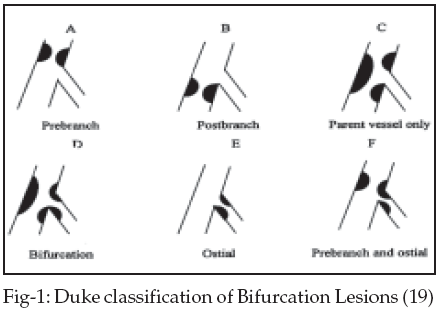
Definitions:
Side branch compromise (SBC):
Occlusion of the side branch with TIMI2
flow or less in the side branch.
Ostial Lesion: Diameter stenosis of 50 percent or more
in the first 3mm of the proximal part of the side branch.
Q-wave myocardial infarction: Formation of the new
Q-wave with a width of at least 0.040 seconds with increasing CK-MB isoenzyme
of at least twice normal.
Non Q-wave myocardial infarction: It was defined as
increasing serum CK MB isoenzyme to twice normal without new Q-waves on ECG.
Baseline characteristics of patients including age, sex,
coronary artery disease risk factors, presence of unstable angina, left
ventricular ejection fraction (EF) and other angiographic findings such as
diameter of the main vessel and also the side branch were recorded.
Statistics:
Continuous variables are presented as
mean ± standard deviation and categorical variables with frequency percentage.
Continuous variables were compared with student’s t-test and frequencies with
chi-squares or Fisher’s exact test. All variables entered the multivariable
stage irrespective of the results of univariable results. P-value less than
0.05 were considered statistically significant. We report crude and
multivariable results with the corresponding 95% confidence interval (CI).
RESULTS
Patients’ characteristics: The mean age of the patients
was 56.1±11.3 (range 32-94). Seventy-four percent of patients were male, 20.2
had diabetes mellitus & 44.2% presented with unstable angina. The details are
given in Table-I.
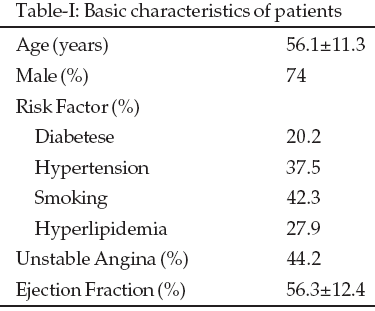
Angiographic analysis: The most frequent lesion was
Type D (36.5%) and the most frequent vessel involved was left anterior
descending/diagonal (62.5%) (Table-II).
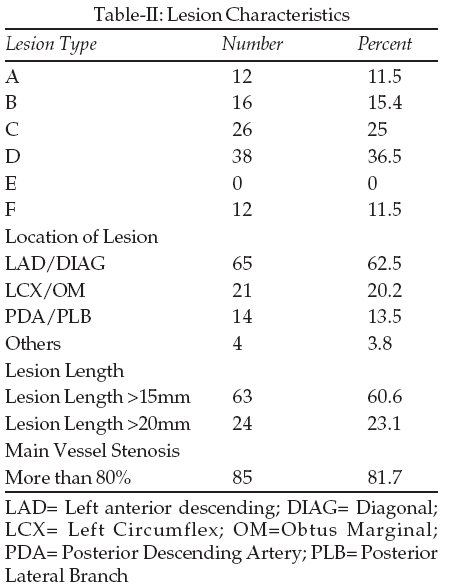
Lesion length was more than 15mm in 60.6% and diameter
stenosis based on QCA was more than 80% in 81.7%. Diameter of the side branch
was greater than 3 mm in 60.6% and less than 2 mm in 39.4%. Direct stenting
was performed in 65.4% and side-branch stenting in 15 patients (14.4%).
Fate of the side branch:
SBC occurred in 41 patients (34.4%), of
whom 30 patients were male (Table-III). There was no statistically significant
correlation between SBC and age, sex, and clinical characteristics. Ejection
Fraction and SBC had no significant statistical correlation. After direct
stenting the probability of SBC was higher than doing predilation and then
implanting the stent in the main branch (p=0.047). When the ostial stenosis
was more than 50%, the probability of SBC was higher than patients without
such a lesion (p=0.021) and when the diameter stenosis of the main vessel was
more than 80%, the probability of SBC was significantly high (p=0.011). Using
multiple logistic regression, only main branch stenosis more than 80% had
significant association with SBC [OD: 5.91; 95% CI (1.28-27.3); p=0.023].
Lesion length had no effect on SBC.
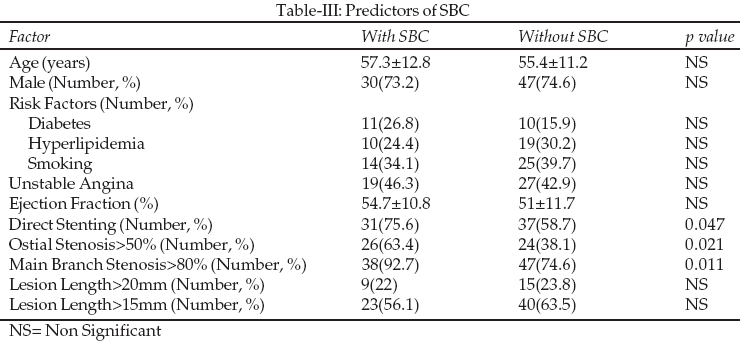
Clinical Results:
Chest pain during or after finishing PCI
occurred in 18 patients (34%), of whom 14 cases were when SBC occurred; only
6.3% of patients without SBC had chest pain and this difference was
significant (p<0.001) (Table-IV). Three non Q-wave MI (2.9%) occurred, all
following SBC (p=0.029). The rate of non Q-wave MI after SBC was 7.3%. In all
of these three cases wiring of the side branch after stenting the main branch
was not successful. We had one death as a result of fatal arrhythmia.
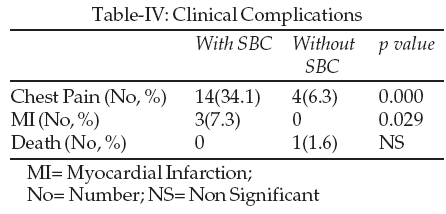
DISCUSSION
Side branches originating from the stenotic portion of a
coronary artery are associated with a higher risk of complications following
PCI.
13
In fact, in the early years of coronary angioplasty, angioplasty of the
bifurcation lesions was considered a contraindication for coronary
angioplasty. In current practice, angioplasty of coronary arteries at the site
of bifurcation comprises about 15% of coronary angioplasties.3
Occlusion of the side branch is a frequent complication
after coronary angioplasty
1,6,14
with a reported incidence of SBO of approximately 35%,15,16
which is in keeping with our study, where we found the incidence of SBC to be
39.4%.
In recent years stenting became the main treatment of
coronary lesions and one of its potential complications is SBO which will
occur as a result of thrombosis or mechanical occlusion.
17
In the study of Aliabadi et al, side branches with ostial stenosis more than
50% had a high incidence of SBO. Interestingly, the site of the lesion,
characteristics of the lesion, stent type and clinical characteristic of the
patients had no correlation with SBO after stenting the main vessel.6
Design and type of stent has been shown to have no effect on early and late
occlusion of the side branch.7
As pointed out in many studies a significant lesion of the ostium of the side
branch seems to be the main predictor of SBC during angioplasty.6,8,15
Many mechanisms have been suggested to explain the cause of
occlusion of the side branches including plaque shift or snow plow effect,
thrombus formation, spasm, ostial recoil, emboli of the plaque, dissection,
covering of the side branch ostium by stent materials and finally endothelial
dysfunction which will particularly occur at the bifurcation site.
1,4,6,11,17,18
By univariable analysis our findings showed that side branches with ostial
stenosis are at high risk during PCI, however using multivariable analysis
ostial stenosis more than 50% did not have a significant correlation with SBO.
This may be because ostial lesions of moderate narrowing will not have the
same outcome as more severe lesions, and volume of plaque will determine the
occurrence of SBC. In our study we did not separate ostial lesions more than
50% on the basis of their severity, which may in part explain our findings.
The finding of a higher frequency of SBC in lesions with
main branch diameter stenosis more than 80% supports the mechanism of snow
plow as the cause of SBC. In some studies using intravascular ultrasound (IVUS)
negative remodeling in bifurcation lesions was seen to be more frequent than
non bifurcation lesions and its cause is unknown.
19
In our study, as in other studies, the incidence of myocardial infarction (MI)
and other clinical complications were low. Chest pain in one study has been
reported to be 15% after occlusion of the side branch20
and in our study it was about 34.1% of patients after occlusion of the side
branch. Although the risk of MI in vessels smaller than 2mm is very low, the
risk of MI is higher in vessels larger than 2mm with a definite stenosis at
the ostium of the side branch, prompting different approaches to be considered
for treating these lesions.5
In our study all of three MI’s were after compromising the side branches
larger than 2mm.
Although many different techniques have been proposed for
treating bifurcation lesions, there is no single intervention with predictable
success rate for saving both the main and side branches.
21
As it has been pointed out in many previous studies, stenting the main vessel
is generally considered to be an acceptable treatment for many coronary
lesions, but in bifurcation lesions superiority of stenting the side branch to
balloon angioplasty has not been established.22,23
Newer techniques including specific bifurcation stents, high pressure stent
implantation and pharmacologic antiplatelet agents are associated with
acceptable clinical results.24
In our study direct stenting was a univariate but not multivariate predictor
of more frequent occurrence of SBO. We believe more evidence is required
before recommending predilation in bifurcation lesions.
Although treatment of bifurcation lesions with drug eluting
stents in historical comparison with bare metal stents (BMS) has lower cardiac
complications, the most effective technique for stenting bifurcation lesions
with DES is unknown.
10,12
On the other hand BMS can be used in bifurcation lesions with acceptable major
adverse cardiac events (MACE).25
The important point is choosing the suitable strategy for treating these
lesions with consideration of potential PCI complications and this was the aim
of our study to define the predictive factors of SBC to choose the best
approach for treatment of these lesions.
CONCLUSION
This study showed the high incidence of procedural and
clinical complications in patients with side branches with more than 50%
ostial lesions and more than 80% diameter stenosis in the main branch. The
incidence of complications in patients with side branches smaller than 2mm is
small. Compromising side branches larger than 2mm can be accompanied by
clinical outcomes as non Q-wave MI. Therefore, in patients with side branches
larger than 2mm which have ostial lesions and or significant diameter stenosis
in the main branch, particular care should be taken to preserve side-branch
flow. On the other hand, lack of evidence showing serious complications in
patients with side branches smaller than 2mm will make the protection of this
vessels unnecessary and will not affect the strategy of treatment of the main
vessel.
Limitations of the study: This study was a single
center study and was non – randomized. In our center the preferred approach in
most cases of bifurcation lesions is stenting the main branch, kissing balloon
inflation and if necessary, provisional stenting of the side branch, so we
didn’t compare different approaches of bifurcation lesion treatments. Finally,
we did not have systematic angiographic follow up for our patients.
REFERENCES
1. Koller P, Safian RD. Bifuraction stenosis. In Freed E,
Safian RD, Grines C, eds. Manual of Interventional Cardiology. Birmingham, MI:
Physician press, 1997;229-41.
2. Takebayashi H, Haruta S, Kohno H, Ichinose H, Taniguchi
M, Shimakura T, et al. Immediate and 3-month follow up outcome after cutting
balloon angioplasty for bifurcation lesions. J Interven Cardiol 2004;17:1-7.
3. Melikian N, Mario CD. Treatment of bifurcation coronary
lesions. J Interven Cardiol 2003;16:507-13.
4. Timurkayank T, Ciftci H, Ozdemir M, Cergel A, Tauil Y,
Kaya M, et al. Sidebranch occlusion after coronary stenting with or without
ballon predilation: Direct versus conventional stenting. J Invasive Cardiol
2002;14(9):497-501.
5. Cervinka P, Foley DP, Sabate M, Coste MA, Serrano P,
Ligthart JMR, et al. Coronary bifurcation stenting using dedicated bifurcated
stents. Cathet Cardivasc Intervent 2000;49:105-11.
6. Aliabadi D, Tilli FV, Bowers TR, Benzuly KH, Safian RD,
Goldstein JA, et al. Incidence and angiographic predictors of side branch
occlusion following high pressure intracoronary stenting. Am J Cardio
1997;80:994-7.
7. Cho GY, Lee CW, Hong M-K, Kim J-J, Park SJ. Effect of
stent design on side branch occlusion after coronary stent plancement. Cathet
Cardiovasc Intervent 2001;52:18-23.
8. Vetrovec GW, Cowely MJ, Wolfgang TC, Ducey KC. Effect of
percutaneous transluminal coronary angioplasty on lesion associated branches.
Am Heart J 1985;109:921-5.
9. Jorgensen E, Helqvist S. Stent treatment of coronary
artery bifurcation lesions. Eur Heart J 2007;28(4):383-5.
10. Steigen TK, Maeng M, Wiseth R, Erglis A, Kumsars I,
Narbute I, et al. Randomized Study on Simple Versus Complex Stenting of
Coronary Artery Bifurcation Lesions: The Nordic Bifurcation Study. Circulation
2006;114(18):1955-61.
11. Karvouni E, Di Mario C, Nishida T, Tzifos V, Reimers B,
Albiero R, et al. Directional atherectomy prior to stenting in bifurcation
lesions. A matched comparison study with stenting alone. Cathet Cardiovase
Intervent 2001;53:12-20.
12. Hoye A, Van Mieghem C, Ong ATL, Aoki J, Rodriguez-Granillo
GA, Valgimigli M, et al. Treatment of de novo bifurcation lesions: Comparison
of, sirolimus – and paclitaxel – eluting stents. Euro Intervention
2005;1:24-30.
13. Meier B, Gruentzig AR, King SB, Douglus JS, Hollman J,
Ischinger T, et al. Risk of side branch occlusion during coronary angioplasty.
Am J Cardiol 1984;53:10-4.
14. Kobayashi Y, Colombo A, Adamina M, Nishida T, Moussa I,
Moses JW. The skirt technique; A stenting technique to treat a lesion
immediately proximal to the bifurcation (pseudobifurcation). Cathet Cardiovase
Intervent 2000;51:347-51.
15. Satler F, Mintz GS, Pichard AD, Kont KM. Bifurcation
disease: To treat or not to treat. Cathet Cardiovase Intervent 2000;50:411-12.
16. Alfonso F, Hernadez C, Perez–Vizcayno MJ, Hernandez R,
Fernandez-Ortz A, Escaned J, et al. Fate of stent – related side branches
after coronary intervention in patients with in – stent restenosis. J Am Coll
Cardiol 2000;36:1549-56.
17. Mathias DW, Mooney JF, Lange HW, Golenberg IF, Gobel
FL, Mooney MR. Frequency of success and complication of coronary angioplasty
of stenosis at the ostium of a branch vessel. Am J Cardiol 1991;67:491-5.
18. Toutouzas K, Stankovic G, Takagi T, Albiero R, Corvaja
N, Milici C, et al. A new dedicated stent and delivery system for the
treatment of bifurcation lesions: Preliminary experience. Cathet Cardiovasc
Intervent 2003;58:34-42.
19. Fujii K, Kobayashi Y, Mintz GS, Hirse M, Moussa I,
Mehran R, et al. Dominant contribution of negative remodeling to development
of significant coronary bifurcation narrowing. Am J Cardiol 2001;92:59-60.
20. Prasad N, Ali H, Schwartz L. Short and long term
outcome of balloon angioplasty for compromised side branches after
intracoronary stent deployment. Cathet Cardiovase Inervent 1999;46:421-4.
21. Marco J, Serruys P, Biamino, Fajadet J, Feyter P,
Morice MC. Current approach for stenting bifurcation lesions. In: Lefevre T,
Louvard Y, Morice MC. The Paris Course on Revascularization 2004;129-54.
22. Pan M, Lezo JS, Medina A, Romero M, Segura J, Ramirez
A, et al. Stepwise strategy for the stent treatment of bifurcated coronary
lesions. Cathet Cardiovasc Intervnt 2002;55:50-7.
23. Yamashita T, Nishida T, Adamina MG, Briguori C,
Vaghetti M, Corvaja N, et al. Bifurcation lesions: two stents Vs one stent:
immediate and follow–up results. J Am Coll Cardiol 2000;35:1145-51.
24. Heuser RR. Coronary lesion: The Good, The Bad and the
Ugly. Cathet Cardiovase Intervent 2000;49:112.
25. Lefever T, Morice MC, Sengottuvel G, Kokis A, Dumas P, Garot P, et al.
Influence of technical strategies on the outcome of coronary bifurcation
stenting. Euro Intervention 2005;1:31-5.
HOME
| SEARCH
| CURRENT
ISSUE | PAST
ISSUES
Professional
Medical Publications
Room No. 522, 5th Floor, Panorama Centre
Building No. 2, P.O. Box 8766, Saddar, Karachi - Pakistan.
Phones : 5688791, 5689285 Fax : 5689860
pjms@





